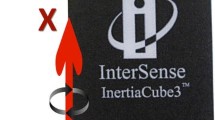Abstract
To direct interventions aimed at improving scapular position and motion in shoulder pathologies, a clinically feasible, objective, sensitive and reliable assessment of scapular dyskinesis is needed. The aim of this study is to evaluate the intra- and inter-observer reliability and the precision of 3D scapula kinematics measurement using wireless sensors of an inertial and magnetic measurement system (IMMS). Scapular kinematics during humerus anteflexion and abduction of 20 subjects without shoulder pathologies were measured twice by two observers at two different days, using IMMS. Similar movement patterns and corresponding high intraclass correlation coefficients were found within (intra) and between (inter) observers, especially for scapular retraction/protraction (0.65–0.85) and medio/lateral rotation (0.56–0.91). Lowest reliability and highest difference in range of motion were observed for anterior/posterior tilt. Medio/lateral rotation and anterior/posterior tilt showed a high precision, with standard error of measurement being mostly below 5°. The inter-observer measurements of retraction/protraction showed lowest precision, reflected in systematic differences. This is caused by an offset in anatomical calibration of the sensors. IMMS enables easy and objective measurement of 3D scapula kinematics. Further research in a patient population should focus on clinical feasibility and validity for measurement of scapular dyskinesis. This would include the application of a scapula locator to enhance anatomical calibration.




Similar content being viewed by others
References
Kibler WB, Ludewig PM, McClure P, Uhl TL, Sciascia A (2009) Scapular Summit 2009: introduction. July 16, 2009, Lexington, Kentucky. J Orthop Sports Phys Ther 39:A1–A13
Kibler WB, Sciascia A (2010) Current concepts: scapular dyskinesis. Br J Sports Med 44:300–305
Veeger HE, van der Helm FC (2007) Shoulder function: the perfect compromise between mobility and stability. J Biomech 40:2119–2129
Wu G, van der Helm FC, Veeger HE, Makhsous M, Van RP, Anglin C, Nagels J, Karduna AR, McQuade K, Wang X, Werner FW, Buchholz B (2005) ISB recommendation on definitions of joint coordinate systems of various joints for the reporting of human joint motion–Part II: shoulder, elbow, wrist and hand. J Biomech 38:981–992
Ludewig PM, Phadke V, Braman JP, Hassett DR, Cieminski CJ, Laprade RF (2009) Motion of the shoulder complex during multiplanar humeral elevation. J Bone Joint Surg Am 91:378–389
McClure PW, Michener LA, Sennett BJ, Karduna AR (2001) Direct 3-dimensional measurement of scapular kinematics during dynamic movements in vivo. J Shoulder Elbow Surg 10:269–277
De Baets L, Jaspers E, Desloovere K, Van DS (2013) A systematic review of 3D scapular kinematics and muscle activity during elevation in stroke subjects and controls. J Electromyogr Kinesiol 23:3–13
Burkhart SS, Morgan CD, Kibler WB (2003) The disabled throwing shoulder: spectrum of pathology Part III: The SICK scapula, scapular dyskinesis, the kinetic chain, and rehabilitation. Arthroscopy 19:641–661
Kibler WB, Sciascia A, Wilkes T (2012) Scapular dyskinesis and its relation to shoulder injury. J Am Acad Orthop Surg 20:364–372
Ludewig PM, Cook TM (2000) Alterations in shoulder kinematics and associated muscle activity in people with symptoms of shoulder impingement. Phys Ther 80:276–291
Ludewig PM, Reynolds JF (2009) The association of scapular kinematics and glenohumeral joint pathologies. J Orthop Sports Phys Ther 39:90–104
Lukasiewicz AC, McClure P, Michener L, Pratt N, Sennett B (1999) Comparison of 3-dimensional scapular position and orientation between subjects with and without shoulder impingement. J Orthop Sports Phys Ther 29:574–583
McClure PW, Michener LA, Karduna AR (2006) Shoulder function and 3-dimensional scapular kinematics in people with and without shoulder impingement syndrome. Phys Ther 86:1075–1090
Struyf F, Nijs J, Baeyens JP, Mottram S, Meeusen R (2011) Scapular positioning and movement in unimpaired shoulders, shoulder impingement syndrome, and glenohumeral instability. Scand J Med Sci Sports 21:352–358
Warner JJ, Micheli LJ, Arslanian LE, Kennedy J, Kennedy R (1992) Scapulothoracic motion in normal shoulders and shoulders with glenohumeral instability and impingement syndrome. A study using Moire topographic analysis. Clin Orthop Relat Res 285:191–199
McClure P, Tate AR, Kareha S, Irwin D, Zlupko E (2009) A clinical method for identifying scapular dyskinesis, part 1: reliability. J Athl Train 44:160–164
Tate AR, McClure P, Kareha S, Irwin D, Barbe MF (2009) A clinical method for identifying scapular dyskinesis, part 2: validity. J Athl Train 44:165–173
Borstad JD, Ludewig PM (2005) The effect of long versus short pectoralis minor resting length on scapular kinematics in healthy individuals. J Orthop Sports Phys Ther 35:227–238
Kibler WB, McMullen J (2003) Scapular dyskinesis and its relation to shoulder pain. J Am Acad Orthop Surg 11:142–151
van Andel CJ, van HK, Eversdijk M, Veeger D, Harlaar J (2009) Recording scapular motion using an acromion marker cluster. Gait Posture 29:123–128
van Andel CJ, Wolterbeek N, Doorenbosch CA, Veeger DH, Harlaar J (2008) Complete 3D kinematics of upper extremity functional tasks. Gait Posture 27:120–127
Karduna AR, McClure PW, Michener LA, Sennett B (2001) Dynamic measurements of three-dimensional scapular kinematics: a validation study. J Biomech Eng 123:184–190
Meskers CG, van de Sande MA, de Groot JH (2007) Comparison between tripod and skin-fixed recording of scapular motion. J Biomech 40:941–946
Barnett ND, Duncan RD, Johnson GR (1999) The measurement of three dimensional scapulohumeral kinematics–a study of reliability. Clin Biomech (Bristol, Avon) 14:287–290
Uhl TL, Kibler WB, Gecewich B, Tripp BL (2009) Evaluation of clinical assessment methods for scapular dyskinesis. Arthroscopy 25:1240–1248
Cutti AG, Ferrari A, Garofalo P, Raggi M, Cappello A, Ferrari A (2010) ‘Outwalk’: a protocol for clinical gait analysis based on inertial and magnetic sensors. Med Biol Eng Comput 48:17–25
van den Noort JC, Scholtes VA, Harlaar J (2009) Evaluation of clinical spasticity assessment in cerebral palsy using inertial sensors. Gait Posture 30:138–143
Zhou H, Hu H, Harris N (2005) Application of wearable inertial sensors in stroke rehabilitation. Conf Proc IEEE Eng Med Biol Soc 7:6825–6828
van den Noort J, van der Esch M, Steultjens MP, Dekker J, Schepers MH, Veltink PH, Harlaar J (2013) Ambulatory measurement of the knee adduction moment in patients with osteoarthritis of the knee. J Biomech 46:43–49
Zhou H, Stone T, Hu H, Harris N (2008) Use of multiple wearable inertial sensors in upper limb motion tracking. Med Eng Phys 30:123–133
de Vries WH, Veeger HE, Cutti AG, Baten C, van der Helm FC (2010) Functionally interpretable local coordinate systems for the upper extremity using inertial & magnetic measurement systems. J Biomech 43:1983–1988
Cutti AG, Giovanardi A, Rocchi L, Davalli A, Sacchetti R (2008) Ambulatory measurement of shoulder and elbow kinematics through inertial and magnetic sensors. Med Biol Eng Comput 46:169–178
Parel I, Cutti AG, Fiumana G, Porcellini G, Verni G, Accardo AP (2012) Ambulatory measurement of the scapulohumeral rhythm: intra- and inter-operator agreement of a protocol based on inertial and magnetic sensors. Gait Posture 35:636–640
Parel I, Cutti AG, Kraszewski A, Verni G, Hillstrom H, Kontaxis A (2014) Intra-protocol repeatability and inter-protocol agreement for the analysis of scapulo-humeral coordination. Med Biol Eng Comput 52:271–282
De Vet HCW, Terwee CB, Knol DL, Bouter LM (2006) When to use agreement versus reliability measures. J Clin Epidemiol 59:1033–1039
Smith SW (1997) Statistics, probability and noise. The scientist and engineer’s guide to digital signal processing. California Technical Publishing, San Diego, CA, USA, pp 32–34
Brennan A, Deluzio K, Li Q (2011) Assessment of anatomical frame variation effect on joint angles: a linear perturbation approach. J Biomech 44:2838–2842
Timmons MK, Thigpen CA, Seitz AL, Karduna AR, Arnold BL, Michener LA (2012) Scapular kinematics and subacromial-impingement syndrome: a meta-analysis. J Sport Rehabil 21:354–370
McGinley JL, Baker R, Wolfe R, Morris ME (2009) The reliability of three-dimensional kinematic gait measurements: a systematic review. Gait Posture 29:360–369
Johnson GR, Stuart PR, Mitchell S (1993) A method for the measurement of 3-Dimensional scapular movement. Clin Biomech 8:269–273
Acknowledgments
The authors want to thank all participants in the study.
Author information
Authors and Affiliations
Corresponding author
Rights and permissions
About this article
Cite this article
van den Noort, J.C., Wiertsema, S.H., Hekman, K.M.C. et al. Reliability and precision of 3D wireless measurement of scapular kinematics. Med Biol Eng Comput 52, 921–931 (2014). https://doi.org/10.1007/s11517-014-1186-2
Received:
Accepted:
Published:
Issue Date:
DOI: https://doi.org/10.1007/s11517-014-1186-2




